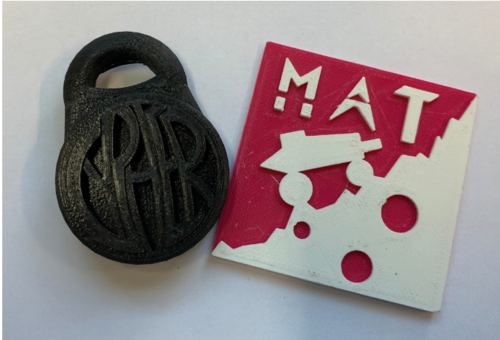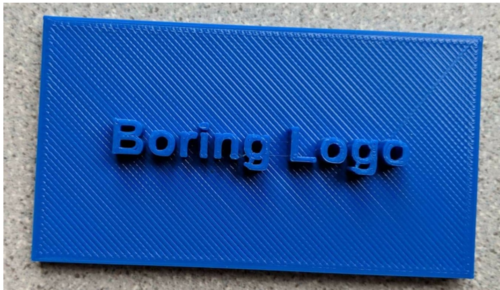Difference between revisions of "3D Printing Guide"
| Line 4: | Line 4: | ||
Groups must submit a .STL file of a logo through the 3D Printing Submission portal by Benchmark A and receive approval from a ProtoLab TA by Benchmark B. The printed logo is a requirement for commissioning, and failure to do so will result in point penalties on the project grade. | Groups must submit a .STL file of a logo through the 3D Printing Submission portal by '''Benchmark A''' and receive approval from a ProtoLab TA by '''Benchmark B'''.'''<span style=”color:red;”>The printed logo is a requirement for commissioning, and failure to do so will result in point penalties on the project grade. </span>''' | ||
= Mandatory 3D Printing for HIR = | = Mandatory 3D Printing for HIR = | ||
Revision as of 03:01, 17 September 2019
Mandatory 3D Printing for all SLDPs
All SLDP groups, except RAD groups, will be required to design and 3D print a one-color logo. All specifications outlined in the Logo specification section must be met. If a group designs and 3D prints a course modification or robot part for extra credit, they will be excused from the mandatory one-color logo 3D print. All groups may design and print a two-color logo to meet the mandatory 3D printing requirement and will receive extra credit for using two colors. Deadlines for this mandatory print are outlined in the deadlines section below.
Groups must submit a .STL file of a logo through the 3D Printing Submission portal by Benchmark A and receive approval from a ProtoLab TA by Benchmark B.The printed logo is a requirement for commissioning, and failure to do so will result in point penalties on the project grade.
Mandatory 3D Printing for HIR
For all students working on the Housing & Innovation in Revit (HIR) project, there will be a mandatory 3D print required for commissioning. Groups must submit a .STL file of a single floor plan through the 3D Printing Submission portal by Benchmark A and receive approval from a ProtoLab TA by Benchmark B Benchmark B. The printed floor plan is a requirement for commissioning, and failure to do so will result in point penalties on the project grade.
3D Printing Extra Credit
The 3D printing extra credit is given for designing a two-color company logo, robot part, or course modification in any CAD (Computer Aided Design) software of your choice and having it approved for printing by a 3D printing specialist. Your designs will then be printed on a first come first served basis (If EG cannot print your design due to time or material constraints you will not be penalized).
Specifications
Logos:
- Maximum material usage does not exceed 15 grams total
- Can be one or two colors
- One color logos are mandatory for all SLDP groups except RAD
- Two color logos are extra credit for all SLDP groups except RAD
- Two STL files are required for two-color logos
- Logos must be integrated with your project in some way:
- Pin worn during final presentation
- Attached to robot during commissioning video
- Add provided Lego technic beam model to your part to allow it to be connected to your robot (in important downloads tab on the EG website)
- Must be original content
- Cannot simply be text on a geometric shape
- Must be .STL extension with correct scaling
Robot Parts:
- Maximum 1 Color
- Maximum print size (7 x 8 x 7 in) and material usage cannot exceed 300 grams
- If a part exceeds the maximum size, it cannot be split into multiple pieces for printing
- Object may not be touched after the robot has started to run
- Original Design
- Must be different from other groups’ submissions
- Will be judged by 3D printing TA’s and Professors
- Must have functional purposes and can help the robot in traversing through the course in some way; cannot be used for aesthetic purposes
- Must be .STL extension with correct scaling
Course Modifications:
- Maximum 1 Color
- Can be printed in multiple parts; up to two Ultimaker buildplates (7 x 8 x 7 inches)
- Must be used as one part
- Different printed parts must be assembled together
- Printed parts cannot be taped or glued together
- Object may not be touched after the robot has started to run
- Original Design
- Must be different from other groups’ submissions
- Will be judged by 3D printing TA’s and Professors
- Must be .STL extension with scaling
- Submit as .zip file if has multiple parts
Housing in Revit Models:
- One mandatory floorplan for commissioning
- Maximum two additional 3D printed floorplans for extra credit
- Maximum print size 7 x 8 x 7 in
- Wall height must be to scale with the floorplan
- If printing multiple floors, second and third floors must nest on top of first floor
- Elevator shafts aligning, stairs aligning, etc.
- Original designs
- Must be different from other groups' submissions
- Must be .STL extension
- Refer to Revit How To Guide for assistance with STL conversion: https://manual.eg.poly.edu/images/7/78/Revit_How_To_Guide.pdf
Software
To design your logo you will need any CAD software as well as CURA. There are many options for software that can be used, the only necessary feature is that the software can export files as an STL (stereolithography) extension. Some examples of these pieces of software are:
- Autodesk Fusion 360 – Free student edition
- Autodesk Inventor – Free student edition
- 123D – Free (Online)
- TinkerCAD – Free (Online)
- Blender – Free (Open source)
- OpenSCAD – Free (Open source)
- Solidworks – Available in NYU computer labs
- Rhinoceros – Free for mac
To make a 2 color design you will need to save your logo in two separate STL files (one for each color). The two files are then imported into CURA aligned and separate extruders are selected for each color.
Design Considerations
- Make a flat bottom: A large flat bottom increases the adhesion between the build platform and the part, keeping the part from shifting around during a print.
- Keep overhangs close to 45 degrees: Each layer of a 3D print needs to be supported from below. You can avoid adding additional supports to a print if all the overhanging parts are at no more than a 45 degree angle from vertical.
- Avoid thin walls and thin columns: Thin walls and column often do not come out well. The thickness of a thin wall should be a multiple of 0.35mm. Thin columns will usually come out distorted because they melt under the nozzle.
Submission and General Guidelines
- Submission of your 3D designed parts will take place through the EG website using the “3D Printing Submission” tab of the left menu. DO NOT USE THE NORMAL SUBMISSION TAB. Your submissions must be .STL files or .zip files.
- If your logo has two colors, you must compress your two STL files into a .zip file for submission.
- Make sure to submit an STL with the correct scaling.
- If you choose to build your model in inches, remember to convert to millimeters before saving the STL
- After your submission has been received, stop by the Modelshop to work with a ProtoLab TA at your earliest convenience. This process is necessary for your files to be approved and printed.
- Once your design has been approved, you can choose to print it at the EG ProtoLab or self-print it at the MakerSpace. However, if you choose to self-print, it must be first approved by a ProtoLab TA, and the final printed part must be shown to a ProtoLab TA to receive extra credit.
- When you pick up your print, you will receive a “Proof of Approval” that recognizes the validity of your print. Please keep the slip with your printed part at all times - you will not be allowed to use the printed part unless the slip is present.
- As you are submitting your 3D designs for your logos, course modifications, or robot parts, please keep in mind the requirements posted on the EG Manual. If you have any further questions, please stop by the Modelshop and inquire a ProtoLab TA.
Deadlines
Mandatory Prints::
- Initial STL file submission is due July 25, 2019 (Benchmark A).
- The 3D printing process can take multiple revisions, you are required to submit the first attempt by Benchmark A but you will be allowed to make any modifications until the final deadline for Benchmark B. If you miss the Benchmark B deadline, subsequent submissions will not be considered.
- Final STL approval is due August 5, 2019 (Benchmark B).
- No further submissions will be considered after this date
- All submissions must be approved by this deadline
- If you choose to self-print your design, you must first receive approval by Benchmark B deadline and then return to the ProtoLab with your printed part to receive credit by the Final SLDP Submission date (week of August 12, 2019).
- These deadlines are only applicable to mandatory HIR prints, mandatory logo prints, and extra credit prints fulfilling the mandatory logo print requirement.
- Extra Credit floor-plans for HIR are subjected to the extra credit deadlines detailed below
Extra Credit:
- Initial STL file submission is due July 30, 2019(week of Milestone 2).
- The 3D printing process can take multiple revisions, you are required to submit the first attempt by Milestone 2 but you will be allowed to make any modifications until the final deadline of Milestone 3. If you miss the Milestone 2 deadline, subsequent submissions will not be considered.
- Final STL approval is due August 9, 2019 (week of Milestone 3).
- No further submissions will be considered after this date
- All submissions must be approved by this deadline
- If you choose to self-print your design, you must return to the ProtoLab with your printed part to receive credit by the Final SLDP Submission date (week of August 12, 2019).
- Use of self prints is not permitted until the Proof of Approval has been obtained from a Protolab TA
- These deadlines are applicable to all SLDPs extra credits not being used to fulfill mandatory print requirements
- All robot parts, course modifications, and HIR extra credit floor plans
ProtoLab Schedule
- Monday and Thursday 1PM to 3PM
- Tuesday, Wednesday and Friday 12PM to 2PM

